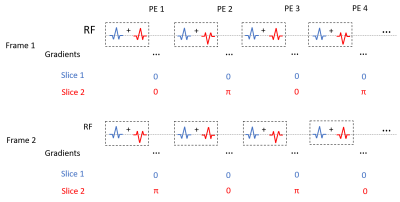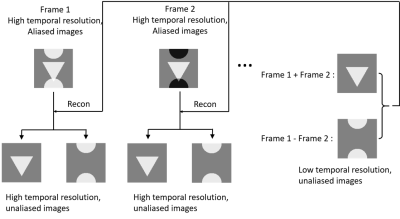4188
Auto-calibrated simultaneous multiband cardiac GRE cine MRI at 5 Tesla1UIH America, Inc., Houston, TX, United States, 2United Imaging Healthcare, Shanghai, China
Synopsis
GRE sequences benefits from increased SNR at high field and do not suffer from banding artifacts and SAR issues as bSSFP sequences, which makes it a good alternative for some applications that typically use bSSFP at 1.5 T or 3T. We have implemented the autocalibrated multiband GRE cardiac cine sequence at 5 T. The autocalibrated multiband acquisition increases the scan efficiency by reducing the scan time and simplifying the multiband imaging workflow. Iterative reconstruction with sparsity constraints was used which can also accommodate in-plane undersampling. We have evaluated this application on volunteers and achieved cardiac cine images with satisfactory quality.
Introduction
Cardiac cine MRI is an important clinical tool for assessing cardiac diseases1. Usually balanced steady-state free precession (bSSFP) sequences are used for SNR and image contrast considerations on 1.5 T and 3 T scanners. However, at even higher field, bSSFP images suffer from severe banding artifacts due to worse B0 homogeneity2; The specific absorption rate (SAR) can also be problematic due to increased RF frequency3. On the other hand, the spoiled gradient-echo sequence (GRE) is free of banding artifact and typically uses smaller flip angles which deposit much less RF energy; Besides, the SNR of GRE sequences also increase with the field strength. Therefore, GRE sequences can be a practical alternative for cardiac cine imaging at high field. Conventional cine only scans one slice at a time, leading to prolonged scan time which not only causes patient discomfort but is also challenging for patients having difficulties in repeated breath-holding. Autocalibrated multiband (MB) imaging4-6 is a promising acceleration technique to tackle this problem. MB imaging leverages coil array sensitivity variations and scans multiple slices simultaneously with minimal SNR penalty. A specially designed phase modulation pattern also enables auto-calibration which eliminates the need for separate scans for single-band reference images. In this study, we implemented the autocalibrated multiband GRE cine sequence. An iterative reconstruction procedure exploiting spatial and temporal sparsity was used to achieve best image quality. The application was evaluated on a 5 T scanner on volunteers.Theory
The autocalibrated multiband GRE cine sequence is demonstrated in Fig.1 using MB = 2 as an example. Phase modulation is achieved by adjusting the RF excitation phase. Taking the first slice as reference, the temporal phase modulation adjusts the phase of the second slice as follows: 1, the phase advances by π for adjacent phase-encoding (PE) steps; 2, the global phase offset alternates between 0 and π for adjacent frames, so that the two slices are in-phase in odd frames and out-of-phase in even frames. Such phase modulation not only produces controlled aliasing for better preserving SNR7, but also allows self-calibration, i.e., extracting low temporal resolution single-band reference images from the MB data themselves by linear combination of the frames (Fig. 2). Coil sensitivity maps are subsequently calculated from the reference images. Cine images are then reconstructed by minimizing the following cost function: $$\underset{x}{\arg\max}\frac{1}{2} \| p_1DF(s_1x_1)+p_2DF(s_2x_2)-y \|_2+ \lambda \|Tx_1\|_1 +\lambda\|Tx_2\|_1 , $$ in which x1 and x2 are the two cine image series of the two slices, s1 and s2 are coil sensitivity maps, p1 and p2 are phase modulations, y is the acquired multi-slice k-space data, D represents the k-space sampling operator, F represents the Fourier transform operator, and T represents the temporal TV operator which is the sparsifying transform for l1 regularization, λ is an adjustable parameter of the regularization strength.Methods
The proposed auto-calibrated multiband GRE cine application was tested on a healthy volunteer on a 5 T scanner (United Imaging Healthcare, Shanghai, China) with an 8-channel RF transmit system. A total of 48 receive channels were used (a 24-channel cardiac coil and a spine coil with 24 channels selected). Imaging parameters include: FOV = 400 × 300 mm, matrix = 256 × 154, thickness = 7 mm, MB factor = 2, gap = 35 mm, bandwidth = 1200 Hz/pixel, FA = 10°, TR = 3.7 ms, TE = 1.8 ms, views per frame=15, number of heart beats = 11. All images were collected in a single breathhold.Results
Fig. 3 zoomed in on the heart and shows 8 frames from systole to diastole. Heart structures were well delineated, and heart motion was well preserved. No obvious artifacts were observed except a dark band near the back, which is likely due to B1 inhomogeneity commonly found on high-field systems.Discussion and Conclusion
We have implemented the autocalibrated multiband GRE Cine sequence at 5 T. This application benefits from increased SNR at high field and does not suffer from issues related to bSSFP. The autocalibrated multiband acquisition reduces the scan time and simplifies the multiband imaging workflow with no need for extra calibration scans. An iterative reconstruction procedure with sparsity constraints was used which can also easily accommodate in-plane undersampling. This application was evaluated on volunteers and achieved cine images that satisfactorily describes cardiac morphology and motion. Overall, the autocalibrated multiband GRE cine application provides a useful alternative for bSSFP cine at 5 T.Acknowledgements
No acknowledgement found.References
1. Carr et al., Cine MR angiography of the heart with segmented true fast imaging with steady-state precession, Radiology. 2001 Jun;219(3):828-34.
2. Bieri et al., Fundamentals of balanced steady state free precession MRI, J Magn Reson Imaging. 2013 Jul;38(1):2-11.
3. Schick, Whole-body MRI at high field: technical limits and clinical potential, Eur Radiol. 2005 May;15(5):946-59.
4. Barth M et al., Simultaneous multislice (SMS) imaging techniques, Magn Reson Med. 2016 Jan;75(1):63-81.
5. Breuer FA, et al., Controlled aliasing in parallel imaging results in higher acceleration (CAIPIRINHA) for multi-slice imaging, Magn Reson Med. 2005 Mar;53(3):684-91.
6. Ferrazzi G, et al., Autocalibrated multiband CAIPIRINHA with through-time encoding: Proof of principle and application to cardiac tissue phase mapping, Magn Reson Med. 2019 Feb;81(2):1016-1030.
7. Setsompop K, et al., Blipped-controlled aliasing in parallel imaging for simultaneous multislice echo planar imaging with reduced g-factor penalty. Magn Reson Med. 2012 May;67(5):1210-24.
Figures


